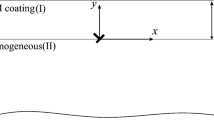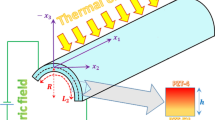Summary
Considered in this paper is a functionally graded piezoelectric material strip (FGPM strip) containing an embedded crack or an edge crack perpendicular to its boundaries. The problem is solved for an FGPM strip that is suddenly heated or cooled from the bottom surface under static mechanical loading. The top surface is maintained at the initial temperature. The crack faces are supposed to be completely insulated. Material properties are assumed to be exponentially dependent on the distance from the bottom surface. First, the transient temperature and the thermal stress distributions in an uncracked strip are calculated by using the Laplace transform. Then, these mechanical and thermal stresses are used as the crack surface traction with opposite sign to formulate the mixed boundary value problem. By using the Fourier transform, the electromechanical problem is reduced to a singular integral equation which is solved numerically. The numerical results for the stress and thermal stress intensity factors are computed as a function of the normalized time, the nonhomogeneous and geometric parameters. The temperature and the thermal stress distributions for the uncracked problem and the results for the crack contact problem are also included.
Similar content being viewed by others
References
Rao S.S. and Sunar M. (1994). Piezoelectricity and its use in disturbance sensing and control of flexible structures: a survey. Appl. Mech. Rev. 47: 113–123
Tauchert T.R. (1992). Piezothermoelastic behavior of a laminated plate. J. Therm. Stress. 15: 25–37
Noda N. and Kimura S. (1998). Deformation of a piezothermoelectric composite plate considering the coupling effect. J. Therm. Stress. 21: 359–379
Ashida F. and Tauchert T.R. (1998). Transient response of a piezothermoelastic circular disk under axisymmetric heating. Acta Mech. 128: 1–14
Ootao Y. and Tanigawa Y. (2000). Three-dimensional transient piezothermoelasticity in functionally graded rectangular plate bonded to a piezoelectric plate. Int. J. Solids Struct. 37: 4377–4401
Wu C.M., Kahn M. and Moy W. (1996). Piezoelectric ceramics with functionally gradients: a new application in material design. J. Am. Ceram. Soc. 79: 809–812
Wang B.L. and Noda N. (2004). The exact thermoelectroelasticity solution for a penny-shaped crack in piezoelectric materials. J. Therm. Stress. 27: 241–251
Wang B.L. and Mai Y.W. (2002). A cracked piezoelectric material strip under transient thermal loading. Trans. ASME J. Appl. Mech. 69: 539–546
Niraula O.P. and Noda N. (2002). Thermal stress analysis in thermopiezoelastric strip with an edge crack. J. Therm. Stress. 25: 389–405
Ueda S. (2003). Thermally induced fracture of a piezoelectric laminate with a crack normal to interfaces. J. Therm. Stress. 26: 311–331
Ueda S. (2006). Thermal stress intensity factors for a normal crack in a piezoelectric strip. J. Therm. Stress. 29: 1107–1126
Ueda S. (2006). The crack problem in piezoelectric strip under thermoelectric loading. J. Therm. Stress. 29: 295–316
Ueda S. (2006). Transient response of a cracked piezoelectric strip under thermoelectric loading. J. Therm. Stress. 29: 973–994
Wang B.L. and Noda N. (2001). Thermally induced fracture of a smart functionally graded composite structure. Theor. Appl. Fract. Mech. 35: 93–109
Ueda S. (2004). Thermally induced fracture of a functionally graded piezoelectric layer. J. Therm. Stress. 27: 291–309
Ueda S. (2007). Thermoelectroelastic response of a center crack in a symmetrical functionally graded piezoelectric strip. J. Therm. Stress. 30: 125–144
Ueda S. (2007). Thermal intensity factors for a parallel crack in a functionally graded piezoelectric strip. J. Therm. Stress. 30: 321–342
Ueda S. (2007). A penny-shaped crack in a functionally graded piezoelectric strip under thermal loading. Engng. Fract. Mech. 74: 1255–1273
Ueda, S.: Effects of crack surface conductance on intensity factors for a cracked functionally graded piezoelectric material under thermal load. J. Therm. Stress. 30, 731–753 (2007)
Ueda, S., Kondo, H.: Transient intensity factors for a parallel crack in a functionally graded piezoelectric strip under thermoelectric loading. J. Therm. Stress. (in press)
Ueda S.: Transient thermoelectroelastic response of a functionally graded piezoelectric strip with a penny-shaped crack. Engng Fract. Mech. 75, 1204–1222 (2007)
Miller M.K. and Guy W.T. (1966). Numerical inversion of the Laplace transform by use of Jacobi Polynomials. SIAM J. Numer. Anal. 3: 624–635
Sneddon I.N. and Lowengrub M. (1969). Crack Problems in the Classical Theory of Elasticity. Wiley, New York
Erdogan F. and Wu B.H. (1996). Crack problems in FGM layers under thermal stresses. J. Therm. Stress. 19: 237–265
Erdogan, F., Gupta, G.D., Cook, T.S.: Methods of Analysis and Solution of Crack Problems. In: Sih, G.C.: (ed) Noordhoff, Leyden (1972)
Wang B.L. and Mai Y.W. (2004). Impermeable crack and permeable crack assumptions, which one is more realistic?. Trans. ASME J. Appl. Mech. 71: 575–578
Author information
Authors and Affiliations
Corresponding author
Rights and permissions
About this article
Cite this article
Ueda, S. A cracked functionally graded piezoelectric material strip under transient thermal loading. Acta Mech 199, 53–70 (2008). https://doi.org/10.1007/s00707-007-0561-6
Received:
Accepted:
Published:
Issue Date:
DOI: https://doi.org/10.1007/s00707-007-0561-6




